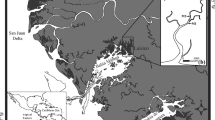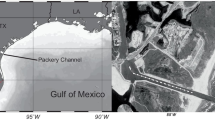Abstract
Diel and tidal studies are critical to understanding many aspects of fish behavior and habitat use. In this study, diel and tidal abundance, size composition and food habits of four common juvenile fish (Anchoa mitchilli, Cynoscion regalis, Leiostomus xanthurus, Micropogonias undulatus) present in Delaware Bay (USA) marsh creeks was assessed. Fish were collected with otter trawls near daytime and nighttime high tides and with seines near daytime and nighttime low tides at two mesohaline sites. Anchoa mitchilli and C. regalis were both significantly more abundant and significantly smaller in nighttime samples. Micropogonius undulatus was the most abundant species, while A. mitchilli was entirely absent, in low tide collections. An index of stomach fullness for A. mitchilli and L. xanthurus indicated feeding during periods of maximum flooding. Trophic interactions among the four species were also apparent. Both C. regalis and M. undulatus commonly consumed A. mitchilli only during nighttime high tides. Cynoscion regalis and M. undulatus both consumed large quantities of Fundulus heteroclitus (mummichog) during low tides during both the day and night. This important interaction demonstrates the trophic transfer of production in the marsh (F. heteroclitus) to the open ocean via the fall migration of piscivorous M. undulatus. These findings demonstrate the need for diel and tidal sampling programs if we are to adequately understand the dynamics of marsh ecosystems.









Similar content being viewed by others
References
Able KW, Fahay MP (2010) Ecology of estuarine fishes: temperate waters of the Western North Atlantic. Johns Hopkins University Press, Baltimore
Able KW, Grothues TM, Hagan SM, Kimball ME, Nemerson DM, Taghon GL (2007) Long-term response of fishes and other fauna to restoration of former salt hay farms: multiple measures of restoration success. Rev Fish Biol Fish 18:65–97
Able KW, Nemerson DM, Bush RO, Light PR (2001) Spatial variation in Delaware Bay (USA) marsh creek fish assemblages. Estuar 24:441–452
Able KW, Nemerson DM, Grothues TM (2004) Evaluating salt marsh restoration in Delaware Bay: analysis of fish response at former salt hay farms. Estuar 27:58–69
Able KW, Nemerson DM, Light PR, Bush RO (2000) Initial response of fishes to marsh restoration of a former salt hay farm bordering Delaware Bay. In: Weinstein MP, Kreeger DA (eds) Concepts and controversies in tidal marsh ecology. Kluwer Academic Publishers, The Netherlands, pp. 749–773
Able KW, Vivian DN, Petruzzelli G, Hagan SM (2012) Connectivity among salt marsh subhabitats: residency and movements of the Mummichog (Fundulus heteroclitus). Estuar Coast 35:743–753
Archambault JA, Feller RJ (1991) Diel variations in gut fullness of juvenile spot, Leiostomus xanthurus (Pisces). Estuar 14:94–101
Blaxter JHS, Hunter JR (1982) The biology of the clupeoid fishes. Adv Mar Biol 20:1–223
Carr WE, Adams CA (1972) Food habits of juvenile marine fishes: evidence of the cleaning habit in the leatherjacket, Oligoplites saurus, and the spottail pinfish, Dilpoidus holbrooki. Fish Bull 70:1111–1120
Casey JM, Myers RA (1998) Diel variation in trawl catchability: is it as clear as day and night? Can J Fish Aquat Sci 55:2329–2340
Chao LN, Musick JA (1977) Life history, feeding habits, and functional morphology of juvenile sciaenid fishes in the York River estuary, Virginia. Fish Bull 75:657–702
Deegan LA, Hughes JE, Rountree RA (2002) Salt marsh ecosystem support of marine transient species pp 333–365 in: Weinstein MP, Kreeger DA (eds) concepts and controversies in tidal marsh ecology. Kluwer Academic Publishers, The Netherlands
Gibson RN, Robb L, Burrows MT, Ansell AD (1996) Tidal, diel and longer term changes in the distribution of fishes on a Scottish sandy beach. Mar Ecol Prog Ser 130:1–17
Gray CA, Chick RC, McElligott DJ (1998) Diel changes in assemblages of fishes associated with shallow seagrass and bare sand. Estuar Coast Shelf Sci 46:849–859
Hagan SM, Able KW (2008) Diel variation in the pelagic fish assemblage in a temperate estuary. Estuar Coast 31:33–42
Herbold B (1985) An alternative to the fullness index. In: Simenstad CA, Caillet GM (eds) Contemporary studies on fish feeding. Springer, Dordrecht, pp 315–320
Hodson RG, Hackman JO, Bennett CR (1981) Food habits of young spots in nursery areas of the cape fear river estuary, North Carolina. Trans Am Fish Soc 110:495–501
Jivoff PR, Able KW (2003a) Evaluating salt marsh restoration in Delaware Bay: the response of blue crabs, Callinectes sapidus, at former salt hay farms. Estuar 26:709–719
Jivoff PR, Able KW (2003b) Blue crab, Callinectes sapidus, response to the invasive common reed, Phragmites australis: abundance, size, sex ratio and molting frequency. Estuar 26:588–596
Juanes F, Conover DO (1993) Rapid growth, high feedings rates, and early piscivory in young-of-the-year bluefish (Pomatomous saltatrix). Can J Fish Aquat Sci 51:1752–1761
Kjelson MA, Peters DS, Thayer GW, Johnson GN (1975) The general feeding ecology of postlarval fishes in the Newport River estuary. Fish Bull 73:137–144
Kleypas J, Dean JM (1983) Migration and feeding of the predatory fish, Bairdiella chrysoura (Lacepede), in an intertidal creek. J Exp Mar Biol Ecol 72:199–209
Kneib RT (1987) Predation risk and use of intertidal habitats by young fishes and shrimp. Ecol 68:379–386
Krebs JR (1978) Optimal foraging: decision rules for predators. In: Krebs J, Davies NB (eds) Behavioral ecology. Blackwell Scientific, Oxford, pp 23–63
Lankford TE Jr, Targett TE (1997) Selective predation by juvenile weakfish: post-consumptive constraints on energy maximization and growth. Ecol 78:1049–1061
Longhurst AR (1976) Vertical migration. In: Cushing DH, Walsh JJ (eds) The ecology of the seas. Saunders Company, Philadelphia, pp 116–137
Midwood JD, Chapman JM, Cvetkovic M, King GD, Ward GD, Suski CD, Cooke SJ (2016) Diel variability in fish assemblages in coastal wetlands and tributaries of the St. Lawrence River: a cautionary tale for fisheries monitoring. Aquat Sci 78:267–277
Miller M, Able KW (2002) Movements and growth of tagged young-of-the-year Atlantic croaker, Micropogonias undulatus, in restored and reference marsh creeks in Delaware Bay. J Exp Mar Biol Ecol 267:15–38
Miller M, Nemerson DM, Able KW (2003) Seasonal distribution, abundance, and growth of young-of-the-year Atlantic croaker (Micropogonias undulatus) in Delaware Bay and adjacent marshes. Fish Bull 101:100–115
Nemerson DM (2001) Trophic dynamics and habitat ecology of the dominant fish of Delaware Bay (USA) marsh creeks. Dissertation, Rutgers University
Nemerson DM, Able KW (2003) Spatial and temporal patterns in the distribution and feeding habits of Morone saxatilis in marsh creeks of Delaware Bay, USA. Fish Ecol Manag 10:337–348
Nemerson DM, Able KW (2004) Spatial patterns in diet and distribution of the juveniles of four fish species in Delaware Bay marsh creeks: factors influencing fish abundance. Mar Ecol Prog Ser 276:249–262
Nemerson DM, Able KW (2005) Juvenile sciaenid fishes respond favorably to marsh restoration in Delaware Bay. Ecol Eng 25:260–274
Nye JA, Loewensteiner DA, Miller TJ (2011) Annual, seasonal, and regional variability in diet of Atlantic croaker (Micropogonias undulatus) in Chesapeake Bay. Estuar 34:691–700
Parker JC (1971) The biology of the spot, Leiostomus xanthurus Lacepede, and Atlantic croaker, Micropogon undulatus (Linnaeus), in two Gulf of Mexico nursery areas. Texas a and M University, sea Grant publication no. TAMU-SG-71-210
R Core Team (2016) R: A language and environment for statistical computing. R Foundation for statistical computing, Vienna, Austria. URL https://www.R-project.org/
Reis RR, Dean JM (1981) Temporal variation in the utilization of an intertidal creek by the bay anchovy. Estuar 4:16–23
Roelofs EW (1954) Food studies of young sciaenid fishes, Micropogon and Leiostomus, from North Carolina. Copeia 1954:151–153
Rogers BD, Herke WH (1987) Diel otter trawl catch of Atlantic croaker, Micropogonias undulatus, in a Louisiana estuary. Northeast Gulf Sci 9:147–152
Rountree RA, Able KW (1993) Diel variation in decapod crustacean and fish assemblages in New Jersey polyhaline marsh creeks. Estuar Coast Shelf Sci 37:181–201
Shenker JM, Dean JM (1979) The utilization of an intertidal salt marsh creek by larval and juvenile fishes: abundance, diversity and temporal variation. Estuar 2:154–163
Sheridan PF (1979) Trophic utilization by three species of sciaenid fishes in a Northwest Florida estuary. Northeast Gulf Sci 3:1–15
Sogard SM, Able KW (1994) Diel variation in immigration of fishes and decapod crustaceans to artificial seagrass habitat. Estuar 17:622–630
Sokal RR, Rohlf FJ (1995) Biometry, 3rd edn. WH Freeman and Company, New York
Stickney RR, Taylor GL, White DB (1975) Food habits of five species of young southeastern United States estuarine Sciaenidae. Chesap Sci 16:104–114
Stoner AW (1991) Diel variation in catch of fishes and penaeid shrimps in a tropical estuary. Estuar Coast Shelf Sci 33:57–69
Teo SLH (2003) Habitat use and movement of the mummichog (Fundulus heteroclitus) in a restored salt marsh. Estuar 26:720–730
Ter Braak CJF, Smilauer P (1998) CANOCO release 4. Reference manual and users guide to CANOCO for windows: software for canonical community ordination. Microcomputer power, Ithaca
Tupper M, Able KW (2000) Movements and food habits of striped bass (Morone saxatilis) in Delaware Bay (USA) salt marshes: comparison of a restored and a reference marsh. Mar Biol 137:1049–1058
Weinstein MP, Balletto JH, Teal JM, Ludwig DF (1997) Success criteria and adaptive management for a large-scale wetland restoration project. Wetl Ecol Manag 4:111–127
Weisberg SB, Whalen R, Lotrich VA (1981) Tidal and diurnal influence on food consumption of a salt marsh killifish Fundulus heteroclitus. Mar Biol 61:243–246
Acknowledgements
This paper would not have been possible without the contributions of numerous, dedicated technicians and students who aided in the field and laboratory portions of this study and especially Jason Morson who provided invaluable data analysis and statistical guidance. We are deeply indebted to them for all of these efforts. This work was funded by the Estuary Enhancement Program at the Public Service Enterprise Group, the Marion Johnson Excellence Fellowship for graduate research, the Manasquan River Marlin and Tuna Club, and the Department of Marine and Coastal Sciences (DMCS) at Rutgers University. Work was performed under Rutgers University IACUC Animal Protocol 88-042.
Author information
Authors and Affiliations
Corresponding author
Additional information
Publisher’s note
Springer Nature remains neutral with regard to jurisdictional claims in published maps and institutional affiliations.
Rights and permissions
About this article
Cite this article
Nemerson, D.M., Able, K.W. Diel and tidal influences on the abundance and food habits of four young-of-the-year fish in Delaware Bay, USA, marsh creeks. Environ Biol Fish 103, 251–268 (2020). https://doi.org/10.1007/s10641-020-00956-x
Received:
Accepted:
Published:
Issue Date:
DOI: https://doi.org/10.1007/s10641-020-00956-x




